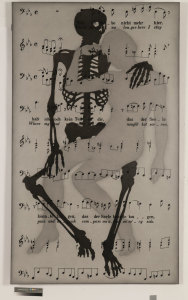ART CITIES:Berlin Sound On The 4th Floor
 Since 2000, the Daimler Art Collection has had its own focus on 20th and 21st Century works that deal with sound/ composition/ language / rhythm in a broad sense. Videos, audio and sound works, sound sculptures, pictures, graphics are presented for the first time in the exhibition “Sound on the 4th Floor” at Daimler Contemporary Berlin.
Since 2000, the Daimler Art Collection has had its own focus on 20th and 21st Century works that deal with sound/ composition/ language / rhythm in a broad sense. Videos, audio and sound works, sound sculptures, pictures, graphics are presented for the first time in the exhibition “Sound on the 4th Floor” at Daimler Contemporary Berlin.
By Efi Michalarou
Photo: Daimler Art Collection Archive

The works of 38 international artists from the Daimler Art Collection are complemented by new acquisitions by Hartmut Landauer and Xavier Veilhan and Gregor Hildebrandt are presented at the exhibition “Sound on the 4th Floor”. Representatives of Bauhaus and Classical Modernism conceive picture series according to musical principles of form with theme and variation or accompany their artistic designs with sound poems and instrumental choreographies. Concrete and Constructive art contain formal inspirations that lend a visual translation to the musical variations of the fugue, the concept of counterpoint or the chord combinations of jazz. Comparable musical references can be found in the Neo Geo art of the 1980s, while other artists simultaneously integrate excerpts of musical scores directly into their pictures. Musical material has been present in multimedia art in many ways since around 1990: Collages with record covers, videos based on everyday sound elements or accompanied by commissioned compositions, further sculptures that vary the forms of musical instruments or places of language and finally computer-generated beats, sounds and frequencies that are audibly underlaid or purely abstractly implemented in order to activate the imagination of the viewer. Gregor Hildebrandt’s signature mediums are cassette tape and vinyl, which he collages and assembles into apparently minimalist yet latently romantic paintings, sculptures and installations. Resting in silence behind the glossy surface of his analog aesthetics, which verges on black-and-white monochrome, music and cinema haunt his practice. Whether pictorial or sculptural, all his works contain pre-recorded materials, which are referenced in the titles. Usually a single song, these pop-cultural sources are meant to trigger both collective and personal memories. Like analog storage mediums, his distinctive rip-off technique is a metaphor for the mnestic process itself: it consists in rubbing magnetic coating against double-sided adhesive tape glued on canvas to trace intricate and elusive powdery patterns. Further relating to architectural Gesamtkunstwerk, Gregor Hildebrandt’s monumental sonic barriers made of stacked, bowl-shaped records, as well as his sensual wall curtains made of unreeled tapes, draw and envelop wandering paths for the visitors of his shows. With his geometric-abstract and non-figurative paintings Günter Fruhtrunk created a striking and extraordinary complete work. The means of design for his work of art is color itself which he wants to liberate from any outer influences, meaning any culturally conveyed or individual meanings. In the end, his pictural language aims at what Fruhtrunk himself calls ‘the exemption from seeing’ by activating the seeing process. In his work this educational impulse bands together with high pictorial sensitivity and quality. His painting proves to be one of the most sustainable and inspiring positions of German post war art. John Tremblay’s abstract paintings strike the viewer at first as optical explorations of pattern and color. Tremblay uses templates to draw black-outlined shapes (rectangles or ovals) on a multicolored canvas in order to isolate areas of color activity. Often, the space between the shapes is filled in with a different color, creating a play between negative and positive space. In one painting, an accumulation of ovals will appear as an organic mass hovering somewhere beyond the picture plane. On another canvas, a wavelike pattern of rectangles of varying sizes creates an undulating movement over the surface. After working professionally as a bookseller, Rune Mields, who is self-taught, has been a free-lance artist in Cologne since the 1970s. Rune Mield’s artistic activities focus on analyzing orders by pictorial and painterly means. She assembles studies and bundles existing order systems pointing to lay their structures open to visual experience in her pictures. Alongside mathematical systems from a wide variety of high cultures, she studies central questions posed by geometry and music, and those relating to the magic square, central perspective, number systems in China, Babylon and Egypt and primal order in various creation myths. Heimo Zobernig’s conceptual work is founded on systems of order drawn from various contexts: the alphabet, the natural numbers, the basic colors or fundamental geometric forms. Zobernig endeavors to introduce order for himself and the beholder into the formalisms of contemporary art by laying bare the mechanisms of presentation, value-generation, and the relation between the genesis of a theory and artistic practice.
On show are works by: Josef Albers, John M Armleder, Jean Arp, Horst Bartnig, Martin Boyce, Adolf Fleischmann, Günter Fruhtrunk, Walter Giers, Camille Graeser, Guan Xiao, Gregor Hildebrandt, Markus Huemer, Bernhard Höke, Takehito Koganezawa, Alicja Kwade, Hartmut Landauer, Verena Loewensberg, Robert Longo, Ma Qiusha, Rune Mields, Kirsten Mosher, Brian O’Doherty, Pak Sheung Chuen, Gerwald Rockenschaub, Peter Roehr, Lerato Shadi, K. R. H. Sonderborg, Anton Stankowski, John Tremblay, Rosemarie Trockel, Andrew Tshabangu, Timm Ulrichs, Xavier Veilhan, Xu Zhen produced by MadeIn Company, Michael Zahn and Heimo Zobernig.
Info: Curators:Renate Wiehager with Nadine Henrich and Sarah Maske, Daimler Contemporary Berlin, Haus Huth, Alte Potsdamer Straße 5, Berlin, Duration 7/7/19-2/2/20, Days & Hours: Daily 11:00-18:00, http://art.daimler.com

